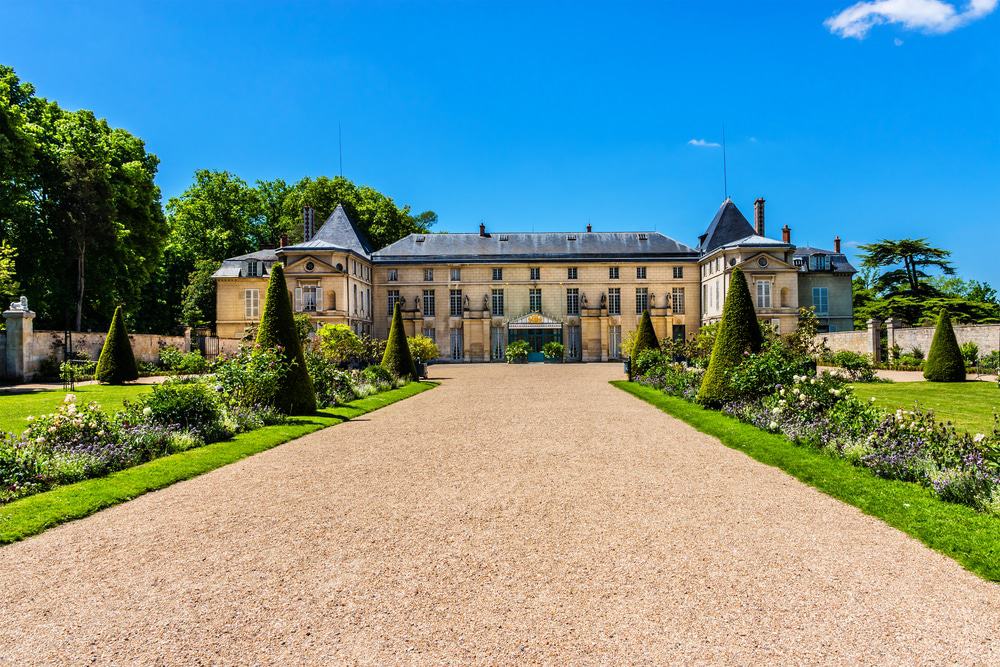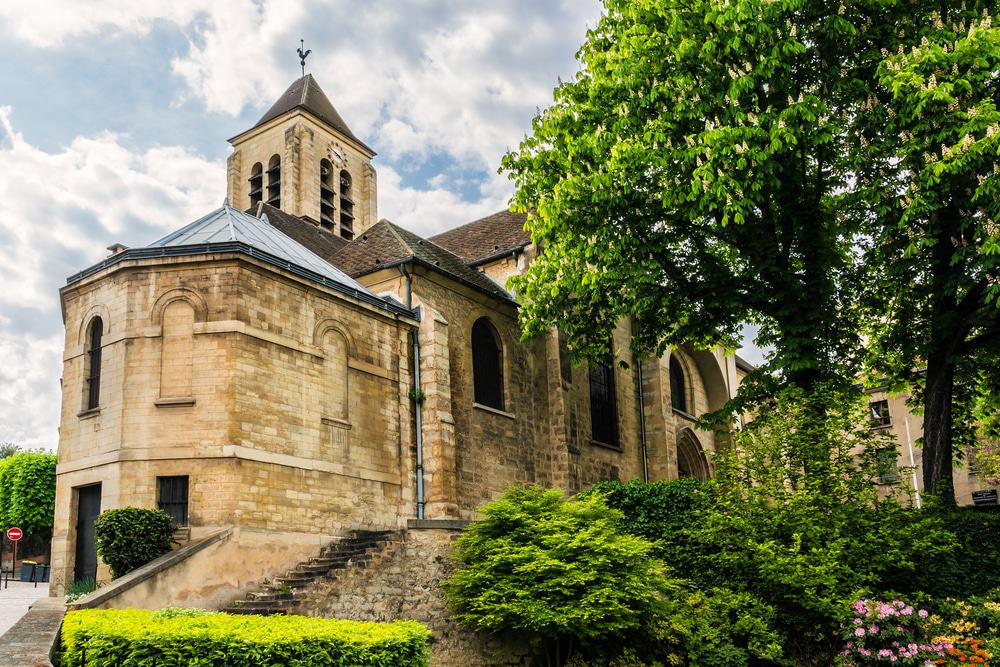Only eight kilometres west of Paris, Rueil-Malmaison is an affluent and leafy suburb loaded with French imperial history. It’s where you can get better acquainted with Joséphine de Beauharnais, wife of Napoleon until their divorce in 1810. You’ll discover the palatial home that she shared with the Emperor, wander the spacious grounds around it and pay your respects at the church containing her tomb.
Rueil-Malmaison is practically overrun with green space, in its fine gardens, deep forests and on the verdant banks of the Seine. So if you’re in search of a serene home from home on a trip to Paris with its own share of sights, Rueil-Malmaison would be a great option.
Lets explore the best things to do in Rueil-Malmaison:
1. Château de Malmaison
 Source: shutterstock
Source: shutterstockJoséphine acquired the Château de Malmaison in 1799 and over the next few years spent astronomical sums improving the house and enriching the grounds.
Between 1800 and 1802 it was even a seat of the French government.
Joséphine meanwhile lavished most of her attention on the gardens, planting 250 varieties of rose and setting up a menagerie with zebras, llamas, antelopes and kangaroos.
Later, following her death and the defeat at Waterloo, Napoleon stayed here during the 100 Days before going into exile.
It’s a marvellous property, drenched in the history of this charismatic family.
The interior is a museum with sumptuous decor, furniture, musical instruments and Sèvres dinnerware belonging to Joséphine and Napoleon.
2. Bois-Préau
 Source: villederueil
Source: villederueilFrom the day Joséphine bought Château de Malmaison she had her eye on this neighbouring property.
But the banker’s daughter who owned it refused to sell, and Joséphine wouldn’t get hold of it until the neighbour was found drowned in the pond in 1808. These 17 hectares are now a gorgeous public park in the English style with generous lawns and mature trees like the Turkish hazels that have been here since Joséphine’s time.
There’s a statue of the empress by the eminent 19th century sculptor Vital-Dubray, and the stage is set by the 18th-century Château de Bois-Préau, which contains a Napoleon museum currently closed for renovations.
3. Château de la Petite Malmaison
 Source: commons.wikimedia
Source: commons.wikimediaWhen the Château de Malmaison’s enormous grounds were divided up this sumptuous pavilion became a separate property and so is now a distinct attraction.
It was built in 1805 by the Louis-Martin Berthault, who would go on to design Joséphine’s tomb.
The Empress was deeply involved in the work because it went hand-in-hand with her passion for botany, and one wing of the building was taken up by a hothouse for growing rare tropical plants.
On a visit you’ll learn about the explorer and botanist, Aimé Bonpland who brought back all of these plants from his travels.
This was also a kind of second home for the painter Pierre-Joseph Redouté, whose depictions of Joséphine’s roses are still popular as postcards today.
4. Église Saint-Pierre-Saint-Paul
 Source: shutterstock
Source: shutterstockThis solemn Renaissance church is best known for housing the tombs of Joséphine and her daughter Hortense.
Joséphine’s funeral was held here on 2 June 1814, and her tomb would be completed 11 years later in 1825. It was a joint effort between architect Louis-Martin Berthault and sculptor Pierre Cartelier, and is carved from Carrara marble.
Hortense was Joséphine’s daughter from a previous marriage (her former husband was killed in the Revolution), and she went on to marry Napoleon’s brother, Louis Bonaparte.
Hortense died in 1837, and her resplendent mausoleum was inaugurated by her son, Napoleon III in 1858.
5. Bois de Saint-Cucufa
 Source: flickr
Source: flickrThe bulk of the Malmaison grounds is a 200-hectare forest, which was finally bought by the state in 1871 to become a public park.
There’s some Joséphine trivia here too because it was after a walk on a cold night beside the park’s pond that she contracted the pneumonia that caused her death.
There’s now a two-kilometre interpretation trail informing you about the park’s history, as well as bike trails and of course that large pond, which is more than two hectares in size.
So you can visit for a jog, easy stroll or to take a picnic by the water.
6. Mont-Valérien
 Source: flickr
Source: flickrIn 1841 Paris invested in a ring of artillery fortifications to prepare for an attack from what is now Germany.
This fortress atop Mont-Valérien, the main rise to the west of Paris, was involved during the Siege of Paris in 1870 and the fight to suppress the Paris Commune in 1871. But its darkest days came during the Second World War when more than a thousand members of the French Resistance and other prohibited groups were executed here.
Later the site was preserved by Charles de Gaulle as a war memorial with an eternal flame and a trail retracing the final steps of the these fighters, as well as a chapel with graffiti by condemned men.
7. Musée d’Histoire Locale
 Source: wikipedia
Source: wikipediaThe old town hall is the home for a museum that covers the history of the city, including some of the ways of life and personalities that might otherwise be forgotten.
For instance, there are details about Rueil-Malmaison’s old winemaking industry, which was killed off by the phylloxera blight at the end of the 1800s.
You can also get perspectives about the Franco-Prussian War and the Siege of Paris, and if you have any lingering curiosity about Empress Joséphine you can indulge it here.
Also from the Napoleonic era is a set of 1,600 figurines representing the Emperor’s Grand Army.
Finally, there’s a whole room dedicated to Édouard Belin, whose Belinograph from 1913 was the predecessor to the wirephoto, capable of sending images down phone lines, long before the invention of the fax.
8. Musée des Gardes Suisses
 Source: wikipedia
Source: wikipediaThe Swiss Guard was a corps of Swiss mercenaries founded by Louis XIII in 1616 and tasked with protecting the king.
These soldiers were renowned for their loyalty, and during the Revolution almost 900 were massacred attempting to defend the Tuileries in 1792. This museum is in one of the three barracks built for the corps in the middle of the 18th century, and every week a detachment would leave this building for Versailles to relieve the “piquet d’honneur ” there.
The building is recognised as a French “historic monument” and has uniforms, documents and other memorabilia relating to the corps.
9. Parc de Saint-Cloud
 Source: shutterstock
Source: shutterstockIf Rueil-Malmaison is all about the empire, the neighbouring suburb of Saint-Cloud has a Royal flavour.
You can see this legacy at the Parc de Saint-Cloud, which is a prestigious French “Jardin Notable” and praised as one of Europe’s loveliest gardens.
On top of that there’s a view of Paris that will knock your socks off from the La Lanterne lookout, with the Eiffel Tower and Sacré-Cœur rippling on a clear summer’s day.
And as for royalty, the park used to be the grounds for the Château de Saint-Cloud, a royal palace destroyed during the Siege of Paris in 1870. Marie Antoinette had been especially fond of the house and planted the flower garden that is still there today.
10. Atelier Grognard
 Source: tripadvisor
Source: tripadvisorThis building is a curious 19th-century factory that once forged thousands of copper, zinc and tin plates for engraving.
Those days are long gone, and the two large halls in the Atelier Grognard are now an evocative venue for temporary art exhibitions.
You should find out what’s on when you come to Rueil-Malmaison because the art is high-quality: In the last few years there have been engravings by Dubuffet, sculptures by Miró, Impressionist paintings of the Seine, Abstract Expressionism from the 50s and works by the famous Rouart family.
11. Arc de Triomphe
 Source: shutterstock
Source: shutterstockRueil-Malmaison is on Line A of the RER commuter train network.
So you can be at the Charles de Gaulle Étoile station beneath the Arc de Triomphe in little over 10 minutes.
Not only is it one of those monuments that almost anybody in the world could identify, it’s also a neat complement to the Château de Malmaison.
Everybody knows what the Arc de Triomphe looks like but not everyone knows it was built to commemorate Napoleon’s conquests, honouring the French soldiers who died in the Revolutionary and Napoleonic Wars.
You can swot up on French military history by studying the six reliefs of key moments in these conflicts, and go up to the roof for an arrow-straight view down the 12 radiating avenues.
12. Paris Museums
 Source: Nattee Chalermtiragool / Shutterstock.com
Source: Nattee Chalermtiragool / Shutterstock.comIn under 20 minutes you can be at Châtelet – Les Halles station, which is roughly between the Pompidou Centre and the Louvre.
So you could plan a day of culture, first by immersing yourself in modern and contemporary art at the Musée National d’Art Moderne.
Every movement and period in modern art is here, together with epochal pieces by Picasso, Matisse Braque and more than we could hope to list.
And then there’s the Louvre, the largest museum in the world.
Say you’re fascinated by an obscure ancient civilisation or period of history, you can be sure to find detailed galleries about it here.
And for everyone else there are dozens of paintings that are part of a shared consciousness: Take Vermeer’s The Lacemaker, Delacroix’s Liberty Leading the People, or of course the Mona Lisa.
13. Versailles
 Source: S-F / Shutterstock.com
Source: S-F / Shutterstock.comOne great advantage of staying in the western suburbs of Paris is the ease with which you can get to Versailles.
It puts another of the region’s unmissable places within a 20-minute drive.
Also, if you only have a day to devote to the gargantuan palace and its grounds you can spend more time exploring.
Because you won’t want to waste a minute, inside the palace gawping at the various royal apartments, Hall of Mirrors and the awesome art in the Museum of the History of France.
Or outside, where the Parterre d’Eau, Orangerie, Grand Trianon, Grand Canal and the Queen’s Hamlet demand as much time as you can spare.
14. Île de la Cité
 Source: flickr
Source: flickrBack to Paris, the shortest of walks from Châtelet – Les Halles is one of the city’s natural islands, crammed with iconic things to see and do.
Of course you have the Notre-Dame Cathedral, a masterwork of French Gothic art and possibly the world’s most famous church, and with a place sealed in history by Victor Hugo.
But you should try see the Conciergerie, a medieval royal palace-turned-prison.
You can enter the very dungeon where Marie Antoinette awaited her execution.
And don’t forget Pont Neuf, the oldest surviving bridge across the Seine in Paris and a point of embarkation for magical cruises on this incomparable river.
15. Golf
 Source: rueil-malmaison.bluegreen
Source: rueil-malmaison.bluegreenAs if to confirm Rueil-Malmaison’s image as an upmarket and leafy sort of place, there are three golf courses in the area.
Le Golf de Paris welcomes beginners, experts and everyone in between.
There’s a nine-hole par 35 course, together with seven different practice facilities, among which is one of the longest driving ranges in Europe.
Golf Blue Green Rueil-Malmaison is a little more demanding, a nine-hole par 32 run by the River Seine.
And then there’s Golf Haras Lupin, a nine-hole par 32 at the southern edge of the Bois de Saint-Cucufa in mature woodland.
